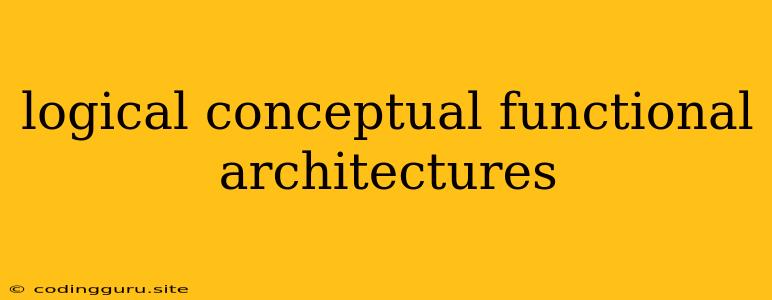Understanding the Essence of Logical, Conceptual, and Functional Architectures
In the world of software development, understanding the different architectural views is crucial for building robust, scalable, and maintainable systems. Three fundamental architectural perspectives often come into play: logical, conceptual, and functional architectures. While they may seem similar at first glance, each offers a distinct lens through which to analyze and design a system. This article explores the differences, interrelationships, and importance of these three architectural styles.
What is a Conceptual Architecture?
Think of a conceptual architecture as the "big picture" vision of your system. It's the high-level blueprint that outlines the major components and their relationships, without delving into specific technical details. It answers the "what" questions:
- What are the key functionalities of the system?
- What are the main components and how do they interact?
- What are the core business processes that the system needs to support?
Conceptual architectures are often depicted using diagrams and models that are easy to understand by both technical and non-technical stakeholders. They help establish a shared understanding of the system's goals and objectives, facilitating communication and alignment across different teams.
What is a Logical Architecture?
The logical architecture takes the conceptual architecture a step further by providing a more detailed view of the system's organization and structure. It focuses on the logical relationships between components, but doesn't specify the physical implementation details.
In simpler terms, the logical architecture defines the "how" of the system. It answers questions like:
- How are the data organized and managed?
- How are different modules and services interconnected?
- How are security and performance considerations addressed?
Logical architecture diagrams often employ notations like UML (Unified Modeling Language) to represent entities, relationships, and interactions.
What is a Functional Architecture?
The functional architecture delves into the specific functionalities and behaviors of the system. It focuses on how the system delivers value to its users by mapping out the interactions and workflows that are needed to achieve desired outcomes.
Functional architecture answers the "what can the system do?" question, defining:
- The user journeys and workflows
- The inputs and outputs of each function
- The interactions between different functions
- The specific business rules and constraints
This level of detail helps developers understand the system's behavior and design efficient and user-friendly solutions.
How are these Architectures Interconnected?
Imagine these three architectural perspectives as layers of a cake. Each layer builds upon the previous one, providing progressively more detailed insights into the system.
- The conceptual architecture is the foundation, setting the overall vision and scope.
- The logical architecture refines this vision by outlining the logical organization and relationships of components.
- The functional architecture defines the specific behaviors and functionalities that bring the system to life.
These architectures are not isolated entities, but rather work together to create a comprehensive understanding of the system. The conceptual architecture provides the high-level roadmap, the logical architecture defines the structure and organization, and the functional architecture specifies the specific behaviors and interactions.
Why are these Architectures Important?
Understanding these three architectural views is crucial for several reasons:
- Clear Communication: They provide a common language and framework for communication between stakeholders, including developers, designers, and business users.
- Effective Design: They guide the design and development process, ensuring that the system meets its goals and requirements.
- Reduced Complexity: They help manage complexity by breaking down a large system into smaller, more manageable components.
- Improved Maintainability: They provide a clear roadmap for future changes and enhancements, making it easier to maintain and evolve the system over time.
Real-World Examples
Let's consider a simple online e-commerce platform:
- Conceptual Architecture: The core functionalities are product browsing, shopping cart, checkout, order management, and customer support.
- Logical Architecture: The system may be organized into modules like product catalog, user management, order processing, and payment gateway.
- Functional Architecture: This would define specific user flows, like browsing products, adding items to the cart, entering payment details, and confirming the order.
Conclusion
Logical, conceptual, and functional architectures provide a powerful framework for understanding and designing complex software systems. By clearly defining these architectural views, developers can ensure that their systems are well-structured, efficient, and maintainable. While each architecture has its distinct focus, they work together to create a cohesive and comprehensive understanding of the system, enabling successful collaboration and effective implementation.
